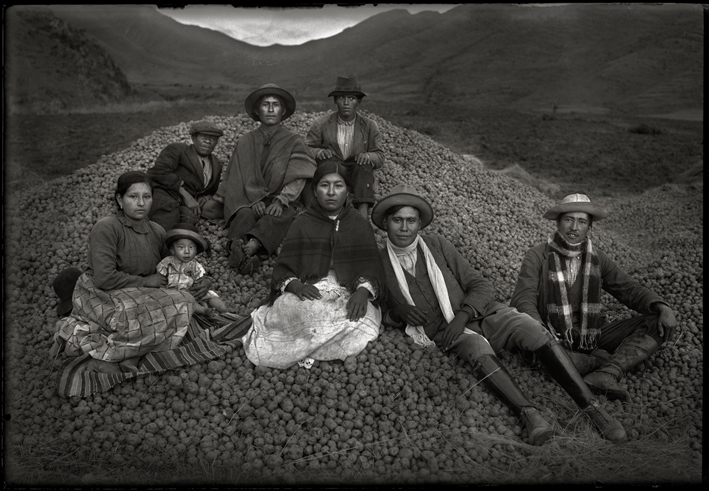February 2018
 1934. “Ezequiel Arce and his papas harvest”, Qatca, (Departamento de Cuzco, Perú) Martín Chambí © Archivo fotográfico Martín Chambí
1934. “Ezequiel Arce and his papas harvest”, Qatca, (Departamento de Cuzco, Perú) Martín Chambí © Archivo fotográfico Martín Chambí
The Andes potato, an essential contribution to world food safety
This image, taken in 1934 by Peruvian photographer Martín Chambi in the Andes community of Qatca (Province of Quispicanchis, Department of Cuzco), over 3,000 metres altitude, takes us into an indigenous millenary tradition: growing potatoes. Recent genetic and archaeological studies indicate that growing papas (“potatoes” in Quechua) began between 8,000 and 4,000 years ago in this geographical region which comprises the south of Peru and the northeast of Bolivia.
The food safety provided by specialisation in growing potatoes was probably linked to the appearance of the State of Tiahuanaco (rising in the 8th century), and then with the expansion of the Incan Empire from present day Argentina to Colombia in the 15th century. This domination of the crop was accompanied by the appearance of several processes for conservation based on the lyophillisation of the tuber, still in use in the Andes, or for example, the preparation of dried potatoes which consists in cooking, peeling, cutting up and drying the potatoes in the sun, and then grinding and storing them, or for Chuño, by a cyclical process of night-time freezing and unfreezing by day.
The arrival of the Spaniards to America, with the invasion of present day Peru in 1532, saw the start of a global voyage of several foodstuffs from the New world to the Old (tomatoes, peppers, beans, cocoa, maize, etc.), including the eventful journey of the potato. Although its existence in America is mentioned between 1537 and 1553 by writers like Juan de Castellanos or Cieza de León, the first records of its cultivation on the other side of the Atlantic date from 1567 in the Canary Islands, in a shipment by a certain Juan de Molina to his brother in Antwerp, and in 1573, on a shopping list for the Hospital de la Sangre in Seville. In 1596 Gaspar Bahuin made the first botanical description giving it the scientific name (Solanumtuberosum), but due to adjustment of cultivation to the new environment and to culinary prejudices, its consumption spread slowly during the 17th century. It was in the 18th century that the paotato spread definitively as a solution to the situation created in Europe by numerous wars and famines. This expansion, and it is worth mentioning the contributions of Frederick II of Prussia and the Frenchman Antoine-AugustinParmentier, was such that some historians point to the food security provided by the potato together with maize as a fundamental factor in the growth of the population and The Great Irish (AnGortaMór or The Great Hunger), which afflicted the country in the decade of 1840 due to the population’s dependence on the potato. The famine came about because of the pathogen Phytophthorainfestans, which destroyed three potato harvests between 1845 and 1848, and resulted in a million dead and the mass emigration of the Irish, mainly to the USA. After its global consolidation (the potato is the third most important crop in terms of consumption after rice and wheat), with 381 million tons harvested in 2014 (FAO statistics), and the three main producers are China, India and Russia, having an average world consumption of 34 kilos a year, being greater in Europe and less, though growing, in Latin America and Africa.
Returning to Martín Chambi’s initial photograph, which takes us to the geographical origin and continuity of the crop, we can finish this brief trip through history mentioning another work of art painted in 1885 and bears witness to the importance of this tuber for the working classes of Europe in the 19th century: “The potato eaters” by Vincent van Gogh (www.vangoghmuseum.nl/en/collection/s0005V1962).
We thank Teo Allain Chambi (Archivo fotográfico Martín Chambi, www.martinchambi.org) for his kindness in allowing this photograph to illustrate this work of the month in the Virtual Museum, and also Blanca Berlín, from the Galería Blanca Berlín, for arranging initial contact, and Dr. Luis Ríos Torres for his ethnographic testimony of the growing and use of the potato in the Peruvian Andes.
